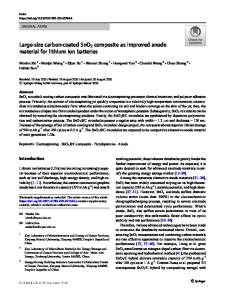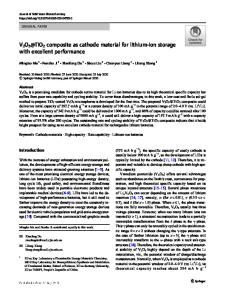Sphere-like TiO 2 /Si anode material with superior performance for lithium ion batteries
- PDF / 4,897,549 Bytes
- 7 Pages / 595.276 x 790.866 pts Page_size
- 88 Downloads / 342 Views
ORIGINAL PAPER
Sphere-like TiO2/Si anode material with superior performance for lithium ion batteries Yu Zhou 1 & Shuai Liu 1 & Fang Liu 1 & Tian Gao 1 & Kai Fu 1 & Aichun Dou 1 & Mingru Su 1 & Yunjian Liu 1 Received: 11 June 2020 / Revised: 21 July 2020 / Accepted: 2 August 2020 # Springer-Verlag GmbH Germany, part of Springer Nature 2020
Abstract The practical application of a titanium dioxide (TiO2) anode is restricted by the poor intrinsic ionic diffusion property and low theoretical capacity. Herein, sphere-like TiO2/Si nanoparticles were synthesized via a facile sol-gel method. Owing to the nanospherical structure and the introduction of Si, the as-prepared TiO2/Si composite exhibits enhanced reversible capacity. Nanostructure of both TiO2 and Si materials provides short Li+ transmission pathways and high diffusion dynamics. The optimum ratio effectively alleviates the volume change of Si nanoparticles. The optimal mass ratio of TiO2/Si is 1:0.15, in which the composite electrode delivers excellent cycling life and rate performance, specifically, reversible capacity of 720.9 mAh g−1 at a current density of 100 mA g−1 and excellent long-term cycling stability with a capacity retention of 86.5% over 400 cycles. Keywords Lithium ion batteries . Anode material . TiO2 . Electrochemical performance
Introduction The rapid development of consumer electronics and electric vehicles has stimulated vastly the research of lithium ion batteries (LIBs) towards higher safety and better electrochemical performance [1–5]. However, the traditional commercial graphite anode has a low rate performance and unsatisfactory safety level with low working potential (0.1 V), which hinder its further application for electric vehicles [6–9]. Among anode materials, titanium dioxide (TiO2) has been regarded as a promising anode candidate due to its low cost, being environmentally friendly, and having safe operating potential (> 1.5 V vs. Li/Li+) [10, 11]. The high working potential can avoid excessive electrolyte decomposition and lithium dendrite formation [12, 13]. The main drawbacks of TiO2 are poor ionic diffusion property and low theoretical capacity (340 mAh g−1) [14, 15]. To overcome the disadvantages of TiO2 as the anode electrode, designing nanostructures and hybridizing TiO2 with other materials have been proven to be effective methods [16, 17]. TiO2 with a specific nanostructure can provide short * Mingru Su [email protected] 1
School of Material Science and Engineering, Jiangsu University, Zhenjiang 212013, People’s Republic of China
transmission pathways and high diffusion dynamics for lithium ion migration [11]. However, owing to the low theoretical capacity and conductivity of TiO2 materials, the improvement of specific capacity and rate performance of TiO2 as anode materials is limited [18]. Moreover, severe aggregation of nanoparticles during the cycling process results in poor longterm performance. In recent years, researchers have tried to combine TiO2 with various high conductive or large theoretical capacity materia
Data Loading...










